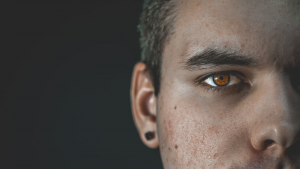There can be different types of double vision problems one can experience during their lifetime. One such condition is called diplopia. Diplopia is where you may notice that objects overlap one another and appear to be duplicated. This condition can occur in one or both eyes.
To find out if you might have diplopia in one or both eyes, close one eye and look at an object. If it appears normal, then the eye may be okay. If not, and things are double, you could have diplopia in that eye. Now, close that eye, open the other eye, and do the same.
If you notice you have diplopia in both eyes, you should avoid driving and performing tasks using heavy machinery and equipment until after you get a comprehensive eye exam and start treatment.
What Causes Diplopia?
Diplopia is caused by abnormalities in the eye, such as astigmatism and cataracts. With astigmatism, the eye shape and curvature can be irregular enough that you have double vision. Cataracts, as they grow, can restrict the natural lens of the eye and lead to double vision.
Other eye conditions that could cause diplopia could include frequent dry eye, keratoconus, and pterygium. With these conditions, the diplopia is typically in just one eye, not both.
Another type of diplopia some people experience is when their eyes are not working together. This is often referred to as binocular diplopia. If you close one eye, the double vision goes away and only seems to be a problem when both eyes are open.
Causes for binocular diplopia include:
- Diabetes
- Graves’ disease
- Nerve Damage
- Myasthenia Gravis
- Strabismus
- Cranial Nerve Palsy
How Is Diplopia Treated?
The type of treatment prescribed by an ophthalmologist will depend on the cause of your diplopia. Some of the more common treatment options are:
- Laser Vision Correction Surgery – The irregularity in the eye may be able to be corrected using advanced laser surgery techniques and result in clear vision afterward.
- Eye Exercises – Exercising weak or strained eyes can help alleviate double vision and improve the strength of the eye.
- Corrective Lenses – Special lenses can be created that help adjust the irregularity so you can see clearly.
- Eye Patch – A temporary solution if you have binocular diplopia is wearing an eye patch. This gives you time to consider your other treatment options and which one is best for you.
Can You Fully Recover from Diplopia?
Most people with diplopia can fully recover and restore their vision once the cause of their diplopia has been diagnosed. By treating the cause for the condition, it is possible to successfully treat and recover from diplopia. For instance, if your diplopia is caused by astigmatism or cataracts, laser eye surgery almost always resolves the diplopia.
What Are the Warning Signs of Diplopia?
You can experience diplopia with or without any noticeable warning signs. Some people notice an increase in headaches shortly before and during the time they experience double vision. Other people might notice their eyes seem to be misaligned and not looking in the same direction. Another possible warning sign might be a pain in the eye when you blink, move it, or try to focus on objects.
How Regular Eye Exams Can Help

Regular eye exams can help identify potential eye problems like diplopia before they become more advanced. You should also schedule an eye exam if you start experiencing double vision before your next scheduled eye exam. The sooner it is diagnosed, the sooner it can be treated.
For further information about diplopia or to schedule a general ophthalmology eye exam for help diagnosing and treating different types of double vision, please feel free to contact Dougherty Laser Vision at (805) 864-5448 today!
We are now offering telemedicine virtual consultations at all of our office locations, including Westlake Village, Camarillo, Beverly Hills, Simi Valley, and Encino.



